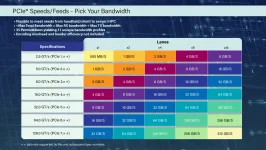PCIe 7.0 has changed everything for data centers that need faster speeds. The latest standard from PCI-SIG runs at 128 GT/s with bi-directional transfers hitting 512 GB/s when using 16 lanes. These speeds matter because quantum computers, AI systems, and 800G Ethernet networks move massive amounts of data every second. Engineers kept the PAM4 signals first seen in PCIe 6.0, letting them reach higher speeds without rebuilding everything from scratch. They made big improvements to signals, channels, and power use without adding delay, plus older cards still work in newer systems.
The technical gains from PCIe 7.0 stand out when compared to previous versions. The old PCIe 3.0 pushed 32 GB/s through 16 lanes, but PCIe 7.0 matches that with just one lane. This makes creating new hardware much easier for engineers. Better signal quality and channel specs help maintain speed and reliability during heavy computing tasks. Companies can upgrade parts of their systems as needed instead of replacing everything at once, saving money and time for tech teams everywhere.
The technical gains from PCIe 7.0 stand out when compared to previous versions. The old PCIe 3.0 pushed 32 GB/s through 16 lanes, but PCIe 7.0 matches that with just one lane. This makes creating new hardware much easier for engineers. Better signal quality and channel specs help maintain speed and reliability during heavy computing tasks. Companies can upgrade parts of their systems as needed instead of replacing everything at once, saving money and time for tech teams everywhere.












